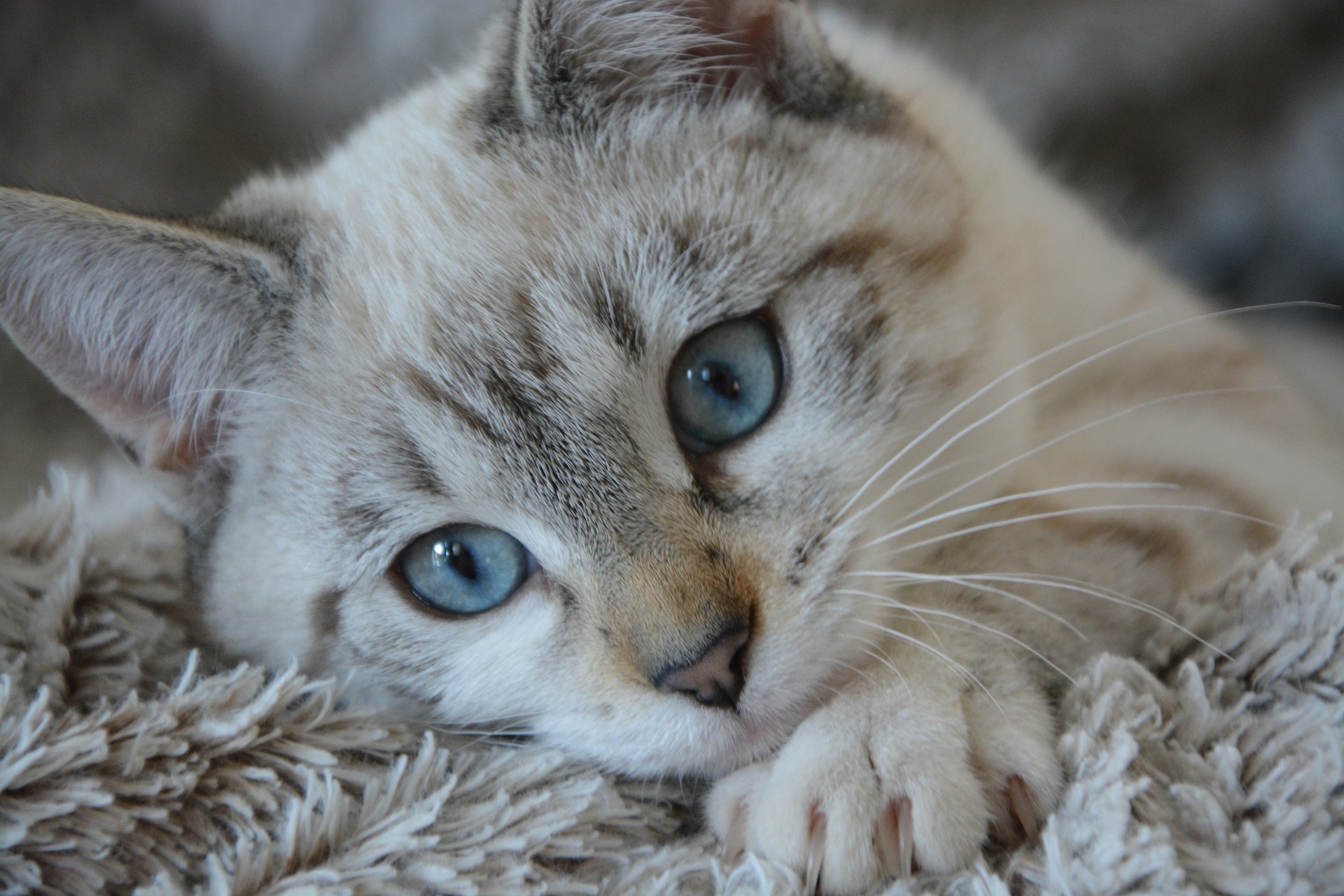Home Remedies for Cat Eye Infection
Last Updated on
A healthy cat’s eyes should be bright and clear, free from inflammation and oozy crust. If you’ve noticed your regularly bright-eyed cat has been showing symptoms of an infection, there’s no doubt you’re worried. Fortunately, cat eye infections can often be helped through at-home care. Let’s learn more about cat eye infection symptoms, causes of infection, and how to help your cat feel better quickly.
Quick Navigation
- 1. Does my cat have an eye infection?
- 2. What causes eye infection in cats and what are the different types of cat eye infections?
- 3. Non-infectious causes of feline conjunctivitis.
- 4. Home remedies for cat eye infection.
- 5. Additional home treatments to help your cat recover from an eye infection quickly.
- 6. How to prevent cat eye infections.
- 7. Remember, you can help your cat’s eye infection.
This post contains affiliate links. If you make any purchases through our links, we may receive a percentage of the sale. Thank you!
Does my cat have an eye infection?
A cat eye infection can affect various parts of the eye area and may appear in one or both eyes. Here are some signs that could indicate that your cat is suffering from an eye infection:
- Redness and swelling around the outer lids, conjunctiva, and the third eyelid
- Excessive discharge from the eyeball
- Squinting, blinking, or holding the eye closed for an extended period of time
- Light sensitivity
- Pawing at the eye
- Crustiness around the eye
If your cat shows any of these symptoms, it’s important that you observe him closely to make sure that the symptoms aren’t getting any worse. If you don’t see any improvement within a couple of days, or if your cat is lethargic or inappetent, it’s probably a good idea to have your cat checked out with a veterinarian.
What causes eye infection in cats and what are the different types of cat eye infections?
Just as eye infections can produce varying symptoms, there are numerous causes of cat eye infection. Your cat’s infection could be bacterial, viral, or fungal. Their symptoms may also be caused by an irritant, not an infection. It can be difficult to identify the cause of your cat’s eye infection unless you get them tested.
Disclaimer: We are not veterinarians. It’s difficult to accurately diagnose your cat at home, and if your cat is showing symptoms of an eye infection, it may be wise to visit a veterinarian. Eye infection symptoms can point to something more serious. The information in this article is intended for use to help cats in stable condition who do not require antibiotics.
Here are a few of the most common types of eye infections that your cat may be suffering from:
Feline upper respiratory infections.
Upper respiratory infections produce cold-like symptoms in cats and are often behind a cat’s red eyes and leaky discharge. The two most common viruses behind feline upper respiratory infections are feline herpesvirus and feline calicivirus. These viruses are easily spread from cat to cat and are very commonly seen in catteries or in multiple cat homes. Kittens are also particularly vulnerable to these viruses. They can be affected at birth if their mother had an infection or the surroundings were unclean.
If feline herpesvirus or calicivirus is the cause of your cat’s eye infection, you’ll likely notice other flu or cold symptoms in conjunction with the eye irritation. Both eyes will typically be affected.
Fortunately, most feline upper respiratory infections clear on their own within 4 – 10 days. As long as your cat is eating regularly, isn’t lethargic, and doesn’t show any other symptoms, he may only require home care to make sure he’s comfortable as he recovers, much like with a human cold.
However, some cats with an upper respiratory infection develop a secondary bacterial infection, which can be life-threatening and may require antibiotics. If your cat doesn’t start feeling better within several days, refuses to eat, or is acting lethargic, contact a vet.
Cat stye.
Your cat may also have a stye—a bacterial infection of the sebaceous gland. A stye can appear on the inside or outside of your cat’s eyelid and might look like a pimple.
A stye causes swelling and can make your cat’s eye area tender and uncomfortable. Fortunately, styes usually don’t require antibiotic treatment and with appropriate home treatment, such as regular warm compresses, should clear up in a week or so.
If you don’t see any reduction in the stye after a few days, it’s a good idea to have the infection looked at by a vet in case the bump is indicative of a more serious condition or requires antibiotics.
Corneal disorders.
Keratitis is inflammation and swelling of the cornea, the clear tissue on the front of your cat’s eye. There are a few different types of keratitis commonly seen in cats, superficial keratitis, interstitial keratitis, and ulcerative keratitis.
The most serious of these issues is ulcerative keratitis, in which slow-healing sores or ulcers develop on the surface of the cornea or deep within the cat’s cornea. Ulcerative keratitis is often associated with feline herpesvirus and can also be caused by foreign objects in the eye or abnormal eye shape.
These corneal ulcers can become worse if your cat develops a secondary bacterial infection. Ulcers are usually detected using a special dye. Traditional treatment includes surgically removing damaged tissue from the ulcer and antibiotic therapy.
Non-infectious causes of feline conjunctivitis.
Eye inflammation isn’t always caused by an infection—there are a number of non-infectious reasons why your cat’s eyes may be red or oozy. Let’s explore some of the non-infectious causes of your cat’s eye inflammation.
Dust particles or smoke.
Dust particles or smoke in your home could irritate your cat’s eyes. Try to mitigate irritating particles by choosing a low-dust litter, keeping your cat away from any home improvement projects, and smoking outside. Consider investing in an air purifier to further reduce irritants.
Allergies.
Allergies can also cause conjunctiva inflammation and can be mediated by limiting your cat’s exposure to irritating substances or providing a select few types of allergy medications. If you suspect that your cat is sensitive to something in the environment and that it’s causing eye irritation, check out our article: Allergy Medicine for Cats: What Can I Give My Cat for Allergies?
Entropion.
While rare, some cats suffer from a condition called entropion. Entropion is a condition where a cat’s eyelid (usually lower) rolls back on itself and this contact irritates the cat’s eye. Some cats are born with the condition, but it usually develops later in life and can be brought on by other causes of eye infection, such as feline herpesvirus. Short-faced breeds such as Persians and Himalayans are also more likely to develop entropion. Entropion usually requires veterinary intervention and the treatment often includes surgery to remove the irritating part of the eyelid.
Tumors.
Eye irritation can also be caused by tumors on or around the eye. If you suspect this may be the case for your cat, take them to a vet to find out what to do next.
Home remedies for cat eye infection.
OTC ophthalmic ointment.
If your cat is suffering from a bacterial infection, they may require antibiotics. Before purchasing an over the counter antibiotic, have a vet confirm that your cat’s infection requires antibiotics, and discuss any treatments you’re considering. If your cat is on any other medications, discuss how the antibiotics could interact with those medications. Note: If you live in the state of California, you will need a prescription from your vet before you can purchase any type of antibiotics for your pet.
Terramycin Ophthalmic Ointment
A popular OTC ophthalmic ointment, Terramycin is a dual antibiotic product containing oxytetracycline hydrochloride and Polymyxin B sulfate.
Terramycin is used to treat conjunctivitis, corneal inflammation, corneal ulcers, and inflamed eyelids. It’s considered safe for cats, but there have been some cases reported in which cats have severe allergic reactions to the ingredients in Terramycin. Always read dosage instructions and follow them closely for your cat. If you notice any facial swelling, itching, or difficulty breathing, call an emergency vet.
Terramycin has a 4.8 out of 5-star rating on Chewy.com.
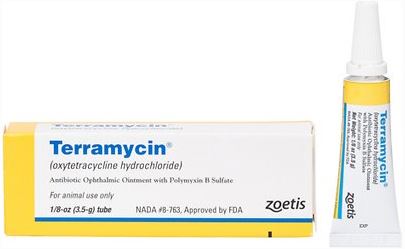
Presciption option for California residents only.
Vetericyn Plus Antimicrobial Ophthalmic Pet Gel
Vetericyn Plus is an antibiotic-free alternative designed to soothe irritated eyes. It does not require a prescription. If your cat is suffering from eye irritation due to foreign particles or allergies, this gel can help to soothe his eyes and ease pain and redness.
Vetericyn Plus has a 4.5 out of 5-star rating on Chewy.com.
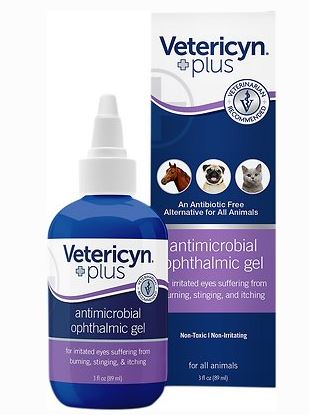
Boric acid.
Boric acid (hydrogen borate) is a mild water-soluble acid that appears in many human eye treatments. This acid is natural and gentle enough to use for your cat’s eye infection. Just take care and make sure that your cat doesn’t eat any of the boric acid—it is toxic if ingested in large amounts.
Boric acid has antiseptic properties and can help to relieve mild bacterial or fungal infections. It can also be used to simply flush out your cat’s eyes if they’ve been exposed to an irritating substance.
You can create a boric acid eye rinse at home using warm water and pharmaceutical-grade boric acid powder. It’s difficult to find references for the exact boric acid to water ratio, and a lot of users seem to adjust the amounts depending on how serious the eye infection is. A pint of warm water to a ¼ teaspoon of boric acid powder seems to be a common starting point. This solution can be administered to your cat’s eyes using an eyedropper.
If you don’t feel comfortable making a homemade boric acid solution, I recommend trying a boric acid eye rinse designed for cats. You can rest assured that you’re using a product that’s been tested and is trusted by other cat guardians.
Nutri-Vet Eye Rinse Liquid is a popular boric acid rinse for cats and has a 4.5 out of 5-star rating on Amazon.com.
Tea bags.
Warm tea bags are a classic folk remedy for eye infections. The damp bag can help to clear out the gunk that may have accumulated on your cat’s eye. If your cat’s symptoms are caused by a foreign object stuck in the eye, this eyewash can help to move it out of your cat’s eye.
Brew a tea bag, let it cool for 15-20 minutes, and then gently press it on your cat’s eye. You can do this a couple of times each day for as long as your cat will tolerate it. Caffeine isn’t good for cats, so choose a decaf tea in case your cat inadvertently licks up some of the tea.
Warm compresses.
In keeping with the above tea bag treatment, any warm compress can help your cat with their eye infection. A warm, moist rag held over your cat’s eye can help to alleviate itching, burning, and crustiness. It can also help to eliminate the swelling associated with a stye.
Additional home treatments to help your cat recover from an eye infection quickly.
While your cat is suffering from an eye infection, there are some things you can do to help manage the situation. If your cat has been scratching or pawing at their eye a great deal, an Elizabethan collar can help keep the eye safe.

While your cat is showing symptoms of an eye infection, keep a close eye on them and record your observations. Even if treatment doesn’t seem like it’s working at first, stay consistent. Depending on the cause of the infection, your cat’s symptoms could continue for a varying length of time.
How to prevent cat eye infections.
Once your cat’s eye infection clears up, your next step is to prevent it from recurring. Let’s take a look at the steps you can take to prevent cat eye infections.
As we’ve learned, viral infections like feline herpesvirus and feline calicivirus are the most common causes of cat eye infections. These viruses are usually passed from cat to cat and are very common in environments where multiple cats are living in close proximity to one another. Even cats who have been vaccinated for these viruses are not immune to them. The best way to prevent your cat from becoming infected with these viruses is to limit your cat’s exposure to unknown animals—don’t let them roam outside where they could come in contact with neighborhood cats. Always take sanitary precautions when you visit an animal shelter or the vet.
If your cat already had herpesvirus, it’s possible for the virus to resurface and cause your cat to become sick again after a period of time. It’s thought that stress can increase the likelihood of cats getting sick, so managing stress may help to minimize the likelihood of an eye infection.
If your cat is suffering from non-infectious eye irritations or allergies, continue to mitigate your cat’s exposure to those irritants.
Remember, you can help your cat’s eye infection.
Fortunately, most eye infections aren’t serious or life-threatening and go away quickly with the right treatment. We hope you found the information in this article helpful and are able to help your cat feel better. Remember, if your cat is showing any more serious symptoms, and you’re not seeing any improvement, it’s time to talk to a veterinarian.
If you have any questions or comments, please let us know!
Did you find this post useful? Pin it for later!
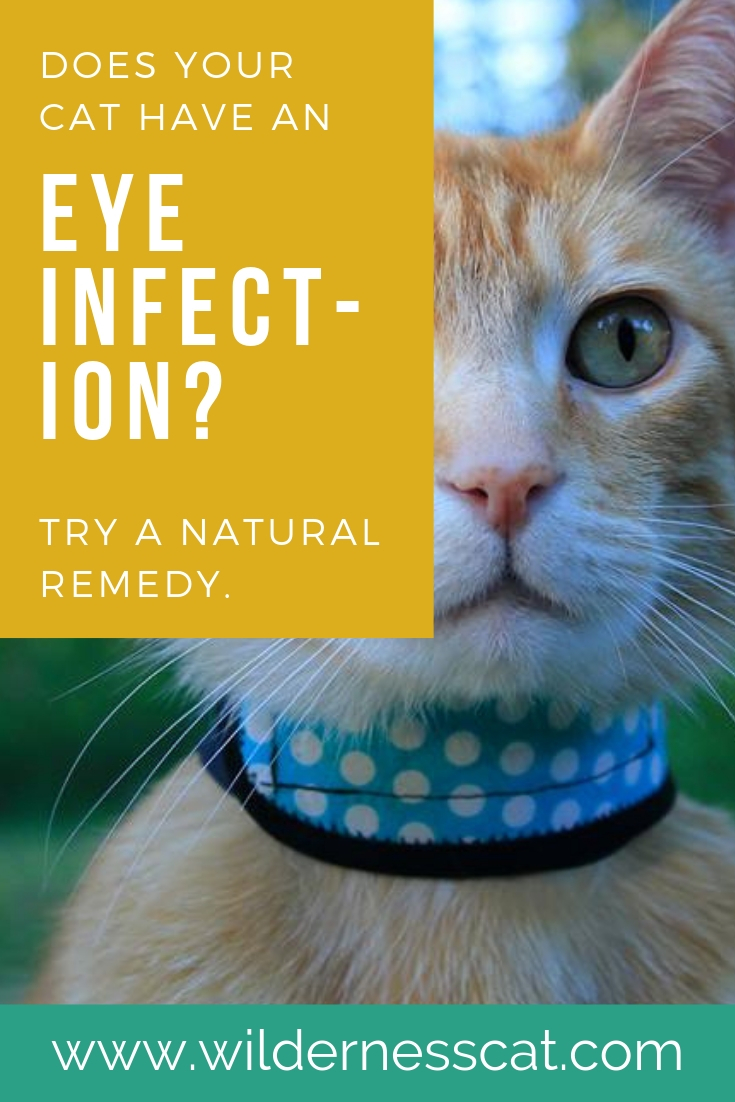
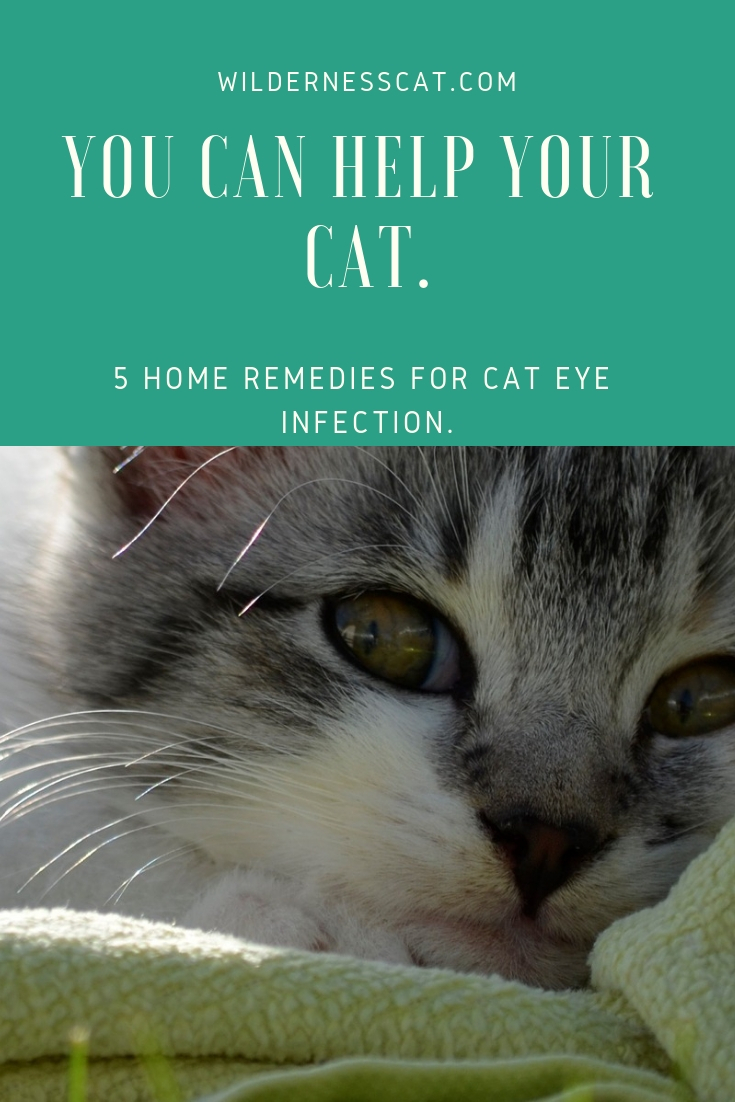
References:
https://www.dvm360.com/view/feline-herpesvirus-and-calicivirus-infections-whats-new-proceedings
https://www.ncbi.nlm.nih.gov/pmc/articles/PMC4647294/
https://www.petcarerx.com/article/entropion-in-cats-an-odd-eye-deformation/1720
https://www.merckvetmanual.com/cat-owners/eye-disorders-of-cats/disorders-of-the-cornea-in-cats
https://petcareadvisors.com/cats/is-the-use-of-boric-acid-eye-wash-for-cats-safe/

